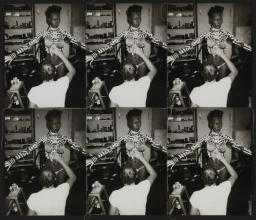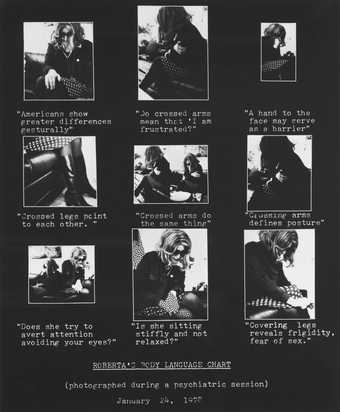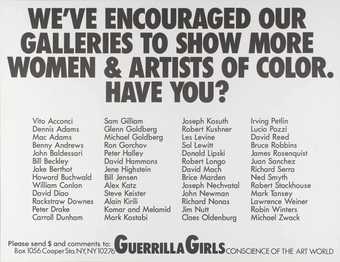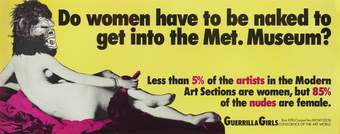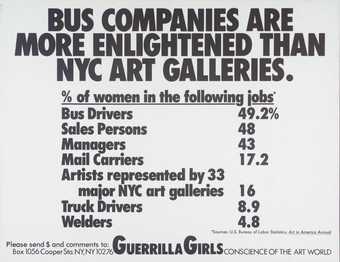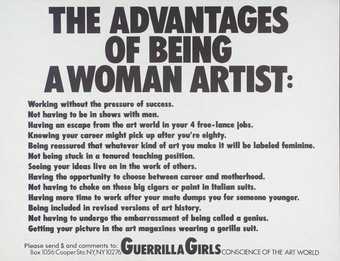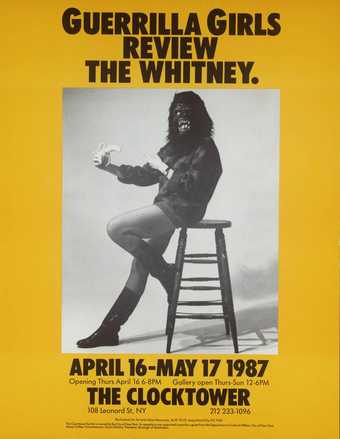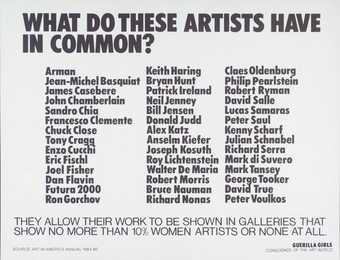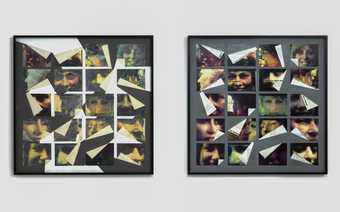
In Tate Liverpool
- Artist
- Lorna Simpson born 1960
- Medium
- 5 photographs, gelatin silver print on paper and 15 engraved plaques
- Dimensions
- Displayed: 622 × 2464 mm
- Collection
- Tate
- Acquisition
- Purchased with funds provided by the 2010 Outset / Frieze Art Fair Fund to benefit the Tate Collection 2010
- Reference
- T13335
Summary
Five Day Forecast 1991 comprises five large-scale framed black and white photographs depicting the torso of a black woman clothed in a loose-fitting white shift. The photographs are displayed close together in a horizontal row. In each one the subject is seen from the front, cropped so that her head and legs are out of the image. She stands with her arms folded tightly across her chest, emphasising the wrinkles in the fabric of her clothing. This pose appears both guarded and defiant. The sequence of photographs, with their subtle variances in the subject’s posture, suggests a series of time-lapse photographs of a figure shifting slightly from side to side.
A series of five plaques, engraved with upper-case text in a simple sans serif font, is installed above the photographs. The plaques are positioned directly above each of the photographs, and bear the names of the days of the week from Monday through to Friday. As the title of the work emphasises, this structure suggests a diary of sorts, or at any rate a ‘forecast’, to use its meteorological metaphor. The similarity of the pose in the photographs, however, suggests the drudgery of repetition with little variation on the horizon.
Underneath the images are ten additional plaques, each featuring a single word. From left to right they read: ‘Misdescription’, ‘Misinformation’, ‘Misidentify’, ‘Misdiagnose’, ‘Misfunction’, ‘Mistranscribe’, ‘Misremember’, ‘Misgauge’, ‘Misconstrue’ and ‘Mistranslate’. The words, with their negative connotations, imply a repeated breakdown in communication, within personal, professional and racial relationships. At the same time, the pun on ‘mis/miss’ raises questions of gender and identity and the exchange of power within such relationships. Curator Okwui Enwezor has described the effect of the catalogue of words: ‘Simpson deploys a staccato devise, a kind of mechanistic action of repetition and differentiation. One feels as if doused with a shower of recriminations.’ (Okwui Enwezor, ‘Repetition and Differentiation – Lorna Simpson’s Iconography of the Racial Sublime’, in Whitney Museum of American Art 2007, p.122.)
Five Day Forecast is typical of Simpson’s work of the mid-1980s, with its formal combination of image and text and examination of the processes through which meaning and understanding take place. In these early works Simpson often used the image of a black woman, photographed cropped, or from behind, against a stark background, and accompanied by text panels. Both text and image are deliberately austere in style. Five Day Forecast was first conceived in 1988, at which time Simpson made two versions of the work using Polaroid photographs; one of these was subsequently damaged. In 1991 she decided to remake the work in an edition with silver gelatin print photographs which she shot with a large format 5 x 4 camera. This later version exists in an edition of three plus one artist’s proof; this is the second in the edition.
Further reading
Kellie Jones, Thelma Golden and Chrissie Iles, Lorna Simpson, London 2002.
Huey Copeland, ‘“Bye, Bye Black Girl”: Lorna Simpson’s Figurative Retreat’, Art Journal, vol.64, no.2, Summer 2005, pp.62–77.
Lorna Simpson, exhibition catalogue, Whitney Museum of American Art, New York 2007.
Rachel Taylor
July 2010
Does this text contain inaccurate information or language that you feel we should improve or change? We would like to hear from you.
Display caption
If portraiture is intended to communicate something unique about its subject, Five Day Forecast might be described as an ‘anti-portrait’. The economy of the images, their serial arrangement and the use of black and white recall the conventions of nineteenth-century ethnographic photography, in which the subject becomes a de-individualised representative of a wider group. But in Simpson’s work, rather than being available for scrutiny and categorisation, the figure is photographed cropped so only her torso is visible. In this way, she remains ultimately inaccessible to the viewer.
Gallery label, November 2015
Does this text contain inaccurate information or language that you feel we should improve or change? We would like to hear from you.
Film and audio
Explore
- emotions, concepts and ideas(16,416)
-
- formal qualities(12,454)
-
- photographic(4,673)
- repetition(391)
- actions: postures and motions(9,111)
-
- arms folded(137)
- woman(9,110)
- black(796)
- government and politics(3,355)
-
- feminism(116)
- inscriptions(6,664)
-
- word(280)
You might like
-
Andy Warhol Grace Jones
1986 -
Andy Warhol Grace being painted by Keith
1986 -
Lynn Hershman Leeson Roberta’s Body Language Chart
1978; printed 2009 -
Guerrilla Girls We’ve Encouraged Our Galleries To Show More Women And Artists Of Color. Have You?
1989 -
Guerrilla Girls Do Women Have To Be Naked To Get Into the Met. Museum?
1989 -
Guerrilla Girls Bus Companies Are More Enlightened Than NYC Art Galleries
1989 -
Guerrilla Girls The Advantages Of Being A Woman Artist
1988 -
Guerrilla Girls Guerrilla Girls Review The Whitney
1987 -
Guerrilla Girls It’s Even Worse In Europe
1986 -
Guerrilla Girls Guerrilla Girls’ Hits List
1986 -
Guerrilla Girls Only 4 Commercial Galleries In NY Show Black Women
1986 -
Guerrilla Girls What Do These Artists Have In Common?
1985 -
Guerrilla Girls Guerrilla Girls’ Identities Exposed!
1990 -
Marie Yates Image/woman/text
1979


